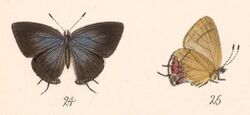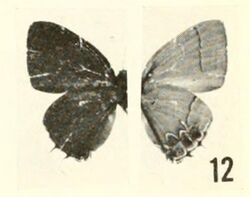Biology:Calycopis pisis
| Calycopis pisis | |
|---|---|

| |
| Male | |

| |
| Male, upper surface on left; under surface on right | |
| Scientific classification | |
| Domain: | Eukaryota |
| Kingdom: | Animalia |
| Phylum: | Arthropoda |
| Class: | Insecta |
| Order: | Lepidoptera |
| Family: | Lycaenidae |
| Genus: | Calycopis |
| Species: | C. pisis
|
| Binomial name | |
| Calycopis pisis (Godman & Salvin, 1887)[1]
| |
| Synonyms[1] | |
Calycopis pisis, the pisis groundstreak, is a butterfly found in several countries in Latin America.
Taxonomic history and synonyms
This species was described in 1887 by Frederick DuCane Godman and Osbert Salvin in Biologia Centrali-Americana. They placed it in the genus Thecla.[2] In 1969, William D. Field transferred the species to his newly-circumscribed genus Calystryma.[lower-alpha 1][3] Then, in 1991, Kurt Johnson transferred it to his newly-circumscribed genus Klaufera[lower-alpha 1] to be its type species. In the same paper, Johnson described a species he named Serratoterga larsoni to honor the American cartoonist Gary Larson;[4][5] this was the type species of Serratoterga.[lower-alpha 1][4] In 2004, R. K. Robins synonymized the two species and transferred it to the genus Calycopis, making C. larsoni an invalid junior synonym.[1][5]
Distribution
It has been found in several parts of Latin America, including Guatemala, Nicaragua, Panama,[2] Honduras,[6] Ecuador,[7] Belize,[8] Mexico (in the states of Veracruz[9][10] and Oaxaca[11]) and in northern Brazil.[4] H. L. Lewis listed a specimen of C. pisis as being from the island of Trinidad, but other lepidopterists have said they believe this to be an error.[12]
A type locality was not initially specified, but the specimen designated as the lectotype was collected in Bugaba, Chiriquí Province, Panama.[3] The type locality for the junior synonym C. larsoni is Santo Domingo, Ecuador.[4]
Description
The forewings measure 13–14.5 mm (0.51–0.57 in) for the males and 13.5 mm (0.53 in) for the female. The wings' underside for both sexes are the same: they are a pale brownish gray with a slight yellow iridescence and with a pattern of red, eye-like markings on the hindwing around the M3 and Cu1 cells (see the Comstock–Needham system of insect wing nomenclature). The upper surface of the male wings are a purple metallic color. The upper surface of the female forewing is dark brown with some blue tint near the basal area. The upper surface of the female hindwings are also dark brown with iridescent blue, with dark brown spots in the M3 and Cu1 cells.[3]
Notes
References
- ↑ 1.0 1.1 1.2 1.3 Savela, Markku. "Calycopis pisis (Godman & Salvin, [1887)"]. http://ftp.funet.fi/pub/sci/bio/life/insecta/lepidoptera/ditrysia/papilionoidea/lycaenidae/theclinae/calycopis/#pisis. Retrieved 1 October 2017.
- ↑ 2.0 2.1 2.2 Godman, Frederick DuCane; Salvin, Osbert (1887). "Thecla pisis, sp. n.". Insecta. Lepidoptera-Rhopalocera. II. (Text). Biologia Centrali-Americana. 2. p. 84; Pl. 57, Figs. 24, 25. https://www.biodiversitylibrary.org/page/589346.
- ↑ 3.0 3.1 3.2 3.3 Field, William D. (1967). "Butterflies of the New Genus Calystryma (Lycaenidae: Theclinae, Strymonini)". Proceedings of the United States National Museum 123 (3611): 17–19. doi:10.5479/si.00963801.123-3611.1. https://www.biodiversitylibrary.org/page/7615419.
- ↑ 4.0 4.1 4.2 4.3 4.4 4.5 Johnson, Kurt (1991). "Neotropical Hairstreak Butterflies: Genera of the "Calycopis/Calystryma Grade" of Eumaeini (Lepidoptera, Lycaenidae, Theclinae) and their Diagnostics". Reports of the Museum of Natural History, University of Wisconsin Stevens Point 21: 15, 20. https://epapers.uwsp.edu/Museum/RMNH%2021a.pdf.
- ↑ 5.0 5.1 Shockley, F. W. (2012). "Diversity, Phenology, and Natural History of Insects and other Arthropods in The Far Side® by Gary Larson". American Entomologist 58 (2): 74. doi:10.1093/ae/58.2.74.
- ↑ Miller, Jacqueline Y.; Matthews, Deborah L.; Warren, Andrew D.; Solis, M. Alma; Harvey, Donald J.; Gentili-Poole, Patricia; Lehman, Robert; Emmel, Thomas C. et al. (2012). "An annotated list of the Lepidoptera of Honduras" (in en). Insecta Mundi 0205: 49. http://digitalcommons.unl.edu/insectamundi/725.
- ↑ Murray, Debra L. (2000). "A Survey of the Butterfly Fauna of Jatun Sacha, Ecuador (Lepidoptera: Hesperioidea and Papilionoidea)". Journal of Research on the Lepidoptera 35: 60. doi:10.5962/p.266571. BHL page 53313363. http://lepidopteraresearchfoundation.org/pdf/pdf35/35-042.pdf. Retrieved 2017-10-04.
- ↑ Shuey, John A.; Giles, Valerie; Meerman, Jan; Labus, Paul; Schutte, Carol W.; Kovarik, Peter (2005). "New Additions to the Butterfly Fauna of Belize". Journal of the Lepidopterists' Society 59 (2): 86. BHL page 41024430. http://images.peabody.yale.edu/lepsoc/jls/2000s/2005/2005(2)83-Shuey.pdf.
- ↑ Ross, Gary N. (1976). "An Ecological Study of the Butterflies of the Sierra de Tuxtla in Veracruz, Mexico (continued)". Journal of Research on the Lepidoptera 15 (2): 189. http://lepidopteraresearchfoundation.org/journals/15/PDF15/15-185.pdf. Retrieved 2017-10-13.
- ↑ Luis-Martínez, Armando; Vargas-Fernández, Isabel; Llorente-Bousquets, Jorge (1995). "Síntesis de los Papilionoidea (Lepidoptera: Rhopalocera) del Estado de Veracruz". Folia Entomológica Mexicana 93: 131. http://repositorio.fciencias.unam.mx:8080/xmlui/handle/11154/56305.
- ↑ Luis Martínez, Armando; Llorente Bousquets, Jorge; Warren, Andrew D.; Vargas Fernández, Isabel (2004). "Los lepidópteros: Papilionoideos y hespeoideos". in García-Mendoza, Abisaí J.; Ordóñez, María de Jesús; Briones-Salas, Miguel. Biodiversidad de Oaxaca. Mexico: UNAM. p. 346. ISBN 978-970-32-2045-8. https://books.google.com/books?id=TQfX0cL3ieQC&pg=PA346.
- ↑ Cock, Matthew; Robbins, Robert K. (2016). "Annotated checklist and biogeographic composition of the Lycaenidae (Lepidoptera) of Trinidad, West Indies". Insecta Mundi 0506: 13. http://digitalcommons.unl.edu/insectamundi/1008/.
External links
- Warren, A. D.; Davis, K. J.; Grishin, N. V.; Pelham, E. M. (2012). "Calycopis pisis (Godman & Salvin, 1887)". Butterflies of America Foundation. http://butterfliesofamerica.com/calycopis_pisis.htm. Retrieved 12 October 2017.
Wikidata ☰ Q25804809 entry
 |

